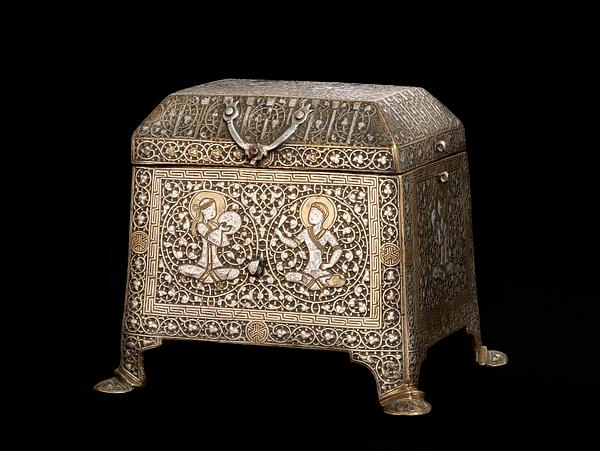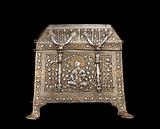Brass casket, engraved and inlaid with gold, silver, and a black substance
Western Iran; 1st half of 14th century
H: 12.8; L: 15.5; D: 12.4 cm
This little casket is exceedingly well preserved, and almost all of the original inlays are intact. It belongs to a group with more or less the same distinctive design: a beveled lid, slightly tapering sides, and animal feet. These caskets were probably used to store jewelry or other valuables.
Their decoration follows the conventions of the period – in this case figures drinking wine and making music. Along the rim of the lid is a frieze with pseudo-calligraphy like the very common type that expresses good wishes for the owner. The tops of the letters were fitted with human faces: animated script.
Inv. no. 24/1962
Published in:
Gaston Migeon: Exposition des arts musulmans au Musée des arts décoratifs, Paris 1903, pl. 18;
C .L. Davids Samling. Fjerde Del : Jubilæumsskrift 1945-70, København 1970, cat.no. 22, pp. 212-213;
André Leth: Davids Samling. Islamisk kunst = The David Collection. Islamic Art, København 1975, pp. 79-80;
Art from the World of Islam. 8th-18th century, Louisiana, Humlebæk 1987, cat.no. 169;
Kjeld von Folsach: Islamic art. The David Collection, Copenhagen 1990, cat.no. 337;
Kjeld von Folsach, Torben Lundbæk and Peder Mortensen (eds.): Sultan, Shah and Great Mughal: the history and culture of the Islamic world, The National Museum, Copenhagen 1996, cat.no. 139;
Kjeld von Folsach: Art from the World of Islam in The David Collection, Copenhagen 2001, cat.no. 513;
Sheila S. Blair and Jonathan M. Bloom (eds.): Cosmophilia. Islamic Art from the David Collection, Copenhagen, McMullen Museum of Art, Boston College, Boston 2006, cat.no. 112;


